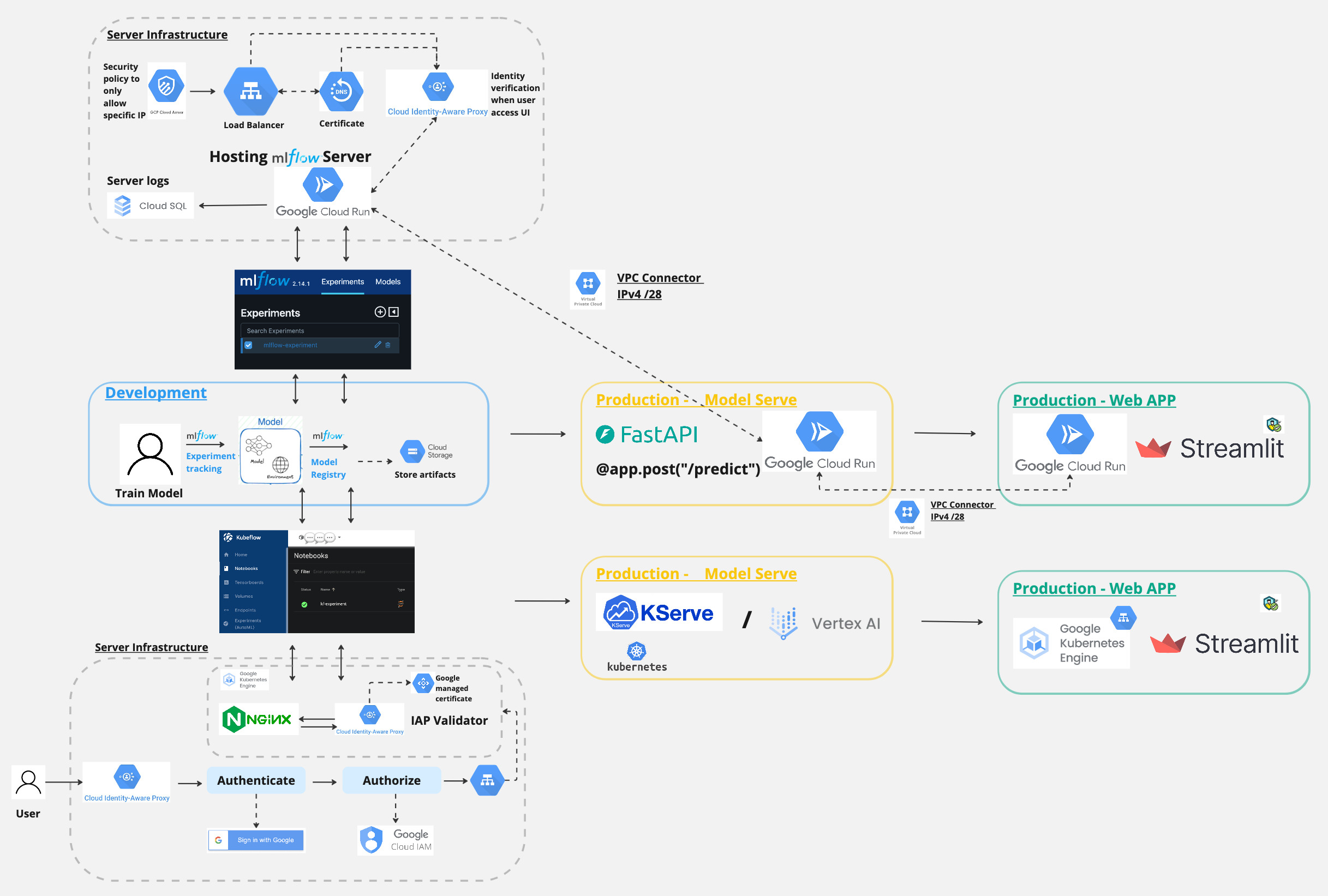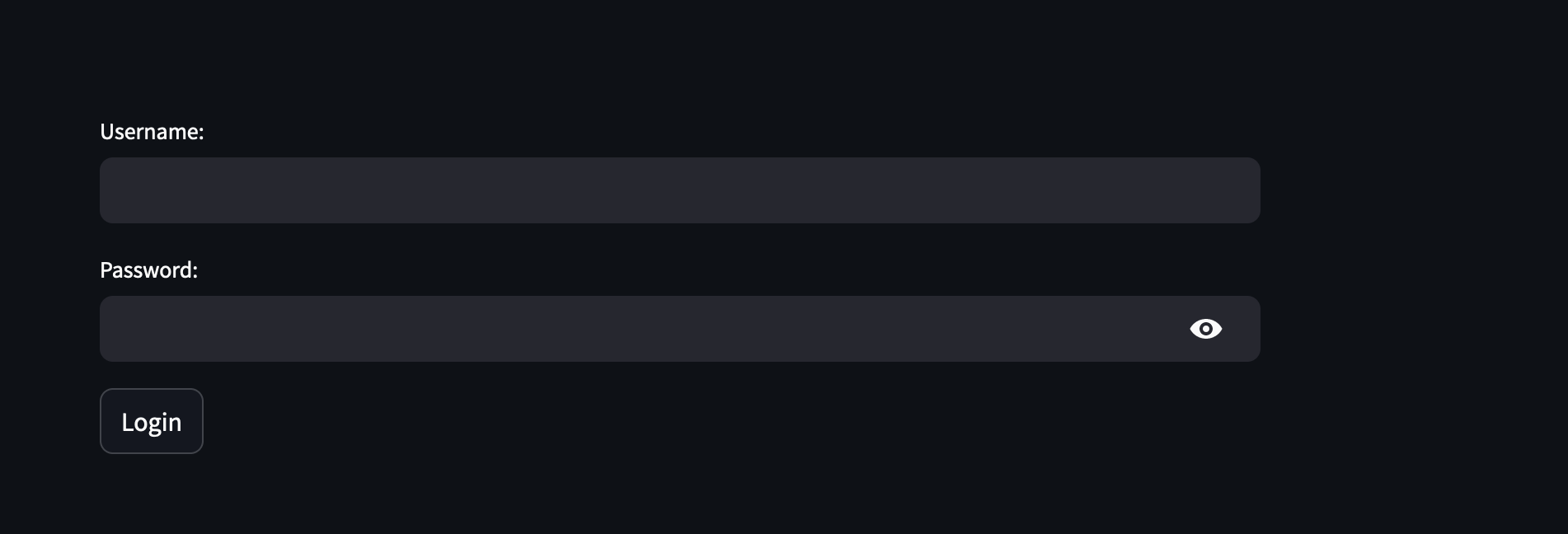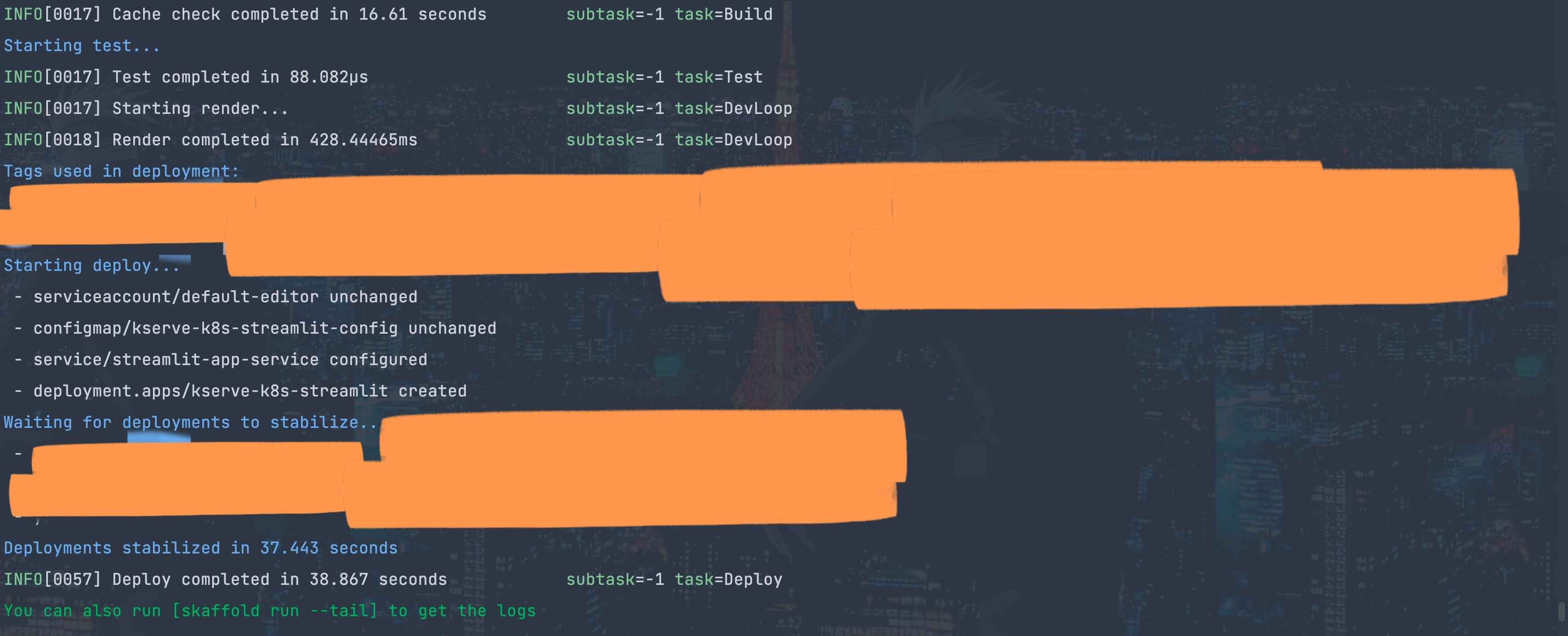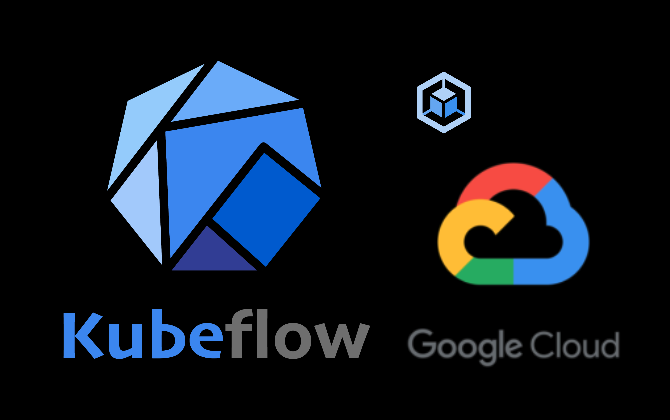Let’s take a look at what we have disuccsed so far:
1 - Setting up MLFlow with CLoud Run with IAP
2 - Setting up Kubeflow with GKE and IAP
Now, in this last article of the MLOps series, we will look in to Streamlit app for machine learning prediction in Cloud Run and GKE.
Architecture
Here is an overview of the MLOPS workflow.

And in today’s post, we will focus on this part.

This article will cover the following topics:
1 - Deploying a Streamlit app to Cloud Run using a MLFlow endpoint deployed on Cloud Run with FastAPI
2 - Deploying a Streamlit app to Cloud Run using Vertex AI Endpoint Serving
3 - Deploying a Streamlit app to GKE using the KServe endpoint deployed on GKE
What is Streamlit?
Streamlit is an open-source app framework. It allows you to create web applications for various use cases, including machine learning models, with minimal effort. It is designed to be easy to use and allows you to create interactive web applications with just a few lines of code.
Setting up the Streamlit app with MLFlow endpoint on Cloud Run
To follow along with this part of the article, you can find the code on the GitHub repository here
Folder strucutre is as below:
.
├── Dockerfile
├── README.md
├── app
│ ├── basic_auth.py
│ ├── gcp_secrets.py
│ ├── main.py
│ └── settings.py
├── deploy
│ └── production
│ └── service.yaml
├── poetry.lock
├── pyproject.toml
└── skaffold.yaml
The settings.py file is as below, note that I have obtained the CREDENTIALS by decoding the base64 encoded string of the username and password for the MLFlow server. Since when we build the FastAPI app in our previous post, we have added the logic to pass the credentials on the header of the requests.
from pydantic_settings import BaseSettings
from gcp_secrets import GCPSecrets
import base64
secrets = GCPSecrets()
class AppConfig(BaseSettings):
MLFLOW_TRACKING_USERNAME: str = secrets.get_secret("mlflow_server_username")
MLFLOW_TRACKING_PASSWORD: str = secrets.get_secret("mlflow_server_password")
MLFLOW_ENDPOINT: str = secrets.get_secret("mlflow_endpoint")
CRED_STR: str = f"{MLFLOW_TRACKING_USERNAME}:{MLFLOW_TRACKING_PASSWORD}"
CRED_BYTES: bytes = str.encode(CRED_STR)
CREDENTIALS: str = base64.b64encode(CRED_BYTES).decode("utf-8")
def get_config() -> AppConfig:
return AppConfig()
app_config = get_config()
Thus in main.py file, when requests are made, it looks something like this
if st.button("Predict"):
response = requests.post(
f"{app_config.MLFLOW_ENDPOINT}/invocations",
json=data,
headers={
"Content-Type": "application/json",
"Authorization": f"Basic {app_config.CREDENTIALS}",
},
)
response.raise_for_status()
prediction = response.json()
The service.yaml file is as below:
apiVersion: serving.knative.dev/v1
kind: Service
metadata:
name: mlflow-wine-streamlit-app
labels:
cloud.googleapis.com/location: us-central1
annotations:
run.googleapis.com/ingress: all
run.googleapis.com/ingress-status: all
spec:
template:
metadata:
annotations:
run.googleapis.com/vpc-access-egress: all-traffic
run.googleapis.com/vpc-access-connector: projects/gcp-prj-id-123/locations/us-central1/connectors/custom-vpc-connector
spec:
serviceAccountName: svc@developer.gserviceaccount.com
containers:
- image: us-central1-docker.pkg.dev/gcp-prj-id-123/mlflow-gcp/mlflow-wine-streamlit-app
ports:
- name: http1
containerPort: 80
env:
- name: GCP_PROJECT_ID
value: gcp-prj-id-123
- name: ENV
value: prod
Dockerfile is as below
FROM python:3.11-slim
WORKDIR /usr/src/app
ENV PYTHONUNBUFFERED=1 \
PYTHONDONTWRITEBYTECODE=1 \
POETRY_VERSION=1.7.1 \
USERNAME=nonroot
RUN adduser $USERNAME
USER $USERNAME
ENV HOME=/home/$USERNAME
ENV PATH="$HOME/.local/bin:$PATH"
RUN pip install pipx
RUN pipx install poetry==${POETRY_VERSION}
COPY ./poetry.lock pyproject.toml /usr/src/app/
RUN poetry install -nv --no-root
COPY app .
EXPOSE 80
CMD ["poetry", "run", "streamlit", "run", "main.py", "--server.port=80", "--server.address=0.0.0.0"]
And the skaffold.yaml file is as below:
apiVersion: skaffold/v4beta2
kind: Config
metadata:
name: mlflow-wine-streamlit-app
build:
artifacts:
- image: us-central1-docker.pkg.dev/gcp-prj-id-123/mlflow-gcp/mlflow-wine-streamlit-app
docker:
dockerfile: Dockerfile
platforms:
- "linux/amd64"
profiles:
- name: production
manifests:
rawYaml:
- deploy/production/service.yaml
deploy:
cloudrun:
projectid: gcp-prj-id-123
region: us-central1
To deploy the Streamlit app to Cloud Run, you can run the following command:
skaffold run -p production

Setting up the Streamlit app with Vertex AI endpoint on Cloud Run
To follow along with this part, you can find the code on the GitHub repository here
The set up is similar to the above, but instead of calling the MLFlow endpoint, we will call the Vertex AI endpoint.
The settings.py file will look something like this:
from pydantic_settings import BaseSettings
from gcp_secrets import GCPSecrets
secrets = GCPSecrets()
class AppConfig(BaseSettings):
MLFLOW_TRACKING_USERNAME: str = secrets.get_secret("mlflow_server_username")
MLFLOW_TRACKING_PASSWORD: str = secrets.get_secret("mlflow_server_password")
GCP_CREDS: str = secrets.get_secret("svc-creds-json")
PROJECT_ID: str = "gcp-prj-id-123"
REGION: str = "us-central1"
ENDPOINT_ID: str = "1234567"
ENDPOINT_URL: str = f"https://{REGION}-aiplatform.googleapis.com/v1/projects/{PROJECT_ID}/locations/{REGION}/endpoints/{ENDPOINT_ID}:predict"
def get_config() -> AppConfig:
return AppConfig()
app_config = get_config()
To obtain a requests header, we will need to do the following:
SCOPES: list = ["https://www.googleapis.com/auth/cloud-platform"]
GCP_CREDS_DICT = extract_json_string(app_config.GCP_CREDS)
credentials = service_account.Credentials.from_service_account_info(
GCP_CREDS_DICT, scopes=SCOPES
)
credentials.refresh(Request())
HEADERS = {
"Authorization": f"Bearer {credentials.token}",
"Content-Type": "application/json",
}
When making prediction, it will look something like this:
if st.button("Predict"):
response = requests.post(
f"{app_config.ENDPOINT_URL}",
headers=HEADERS,
json=inference_input,
)
response.raise_for_status()
prediction = response.json()
pred_result = prediction["predictions"][0]
To deploy the Streamlit app to Cloud Run, you can run the following command:
skaffold run -p production

Setting up the Streamlit app with KServe endpoint on GKE
To follow along with this part, you can find the code on the GitHub repository here
Let’s jump right in.
The folder structure is as below:
.
├── Dockerfile
├── README.md
├── app
│ ├── basic_auth.py
│ ├── gcp_secrets.py
│ ├── main.py
│ └── settings.py
├── deploy
│ ├── common
│ │ ├── config.yaml
│ │ ├── deployment.yaml
│ │ ├── kustomization.yaml
│ │ ├── service.yaml
│ │ └── serviceaccount.yaml
│ └── production
│ └── kustomization.yaml
├── poetry.lock
├── pyproject.toml
└── skaffold.yaml
Before we start configuring the deployment artifacts, there is a few things we need to do
For deployment, in order to pull the image from the Google Container Registry, you need to create/ make sure your node pool has the scopes cloud-platform and storage-full
You can do this by running the following command:
gcloud container node-pools create default-node-pool-new \
--cluster=kubeflow \
--zone=us-central1-c \
--scopes=cloud-platform,storage-full \
--num-nodes=2

Create a json key for accessing the GCP Artifacts Registry
gcloud iam service-accounts keys create key.json \
--iam-account=svc@gcp-prj-id-123.iam.gserviceaccount.com
kubectl create secret docker-registry gar-json-key \
--docker-server=us-central1-docker.pkg.dev \
--docker-username=_json_key \
--docker-password="$(cat key.json)" \
--docker-email=user@email.com
Reference the secret in the deployment.yaml file as shown below:
spec:
serviceAccountName: default-editor
imagePullSecrets:
- name: gar-json-key
Also in serviceaccount.yaml file,
imagePullSecrets:
- name: gar-json-key
Ensure the service account has the role artifactregistry.reader
gcloud projects add-iam-policy-binding gcp-prj-id-123 \
--member "serviceAccount:svc@gcp-prj-id-123.iam.gserviceaccount.com" \
--role "roles/artifactregistry.reader"
gcloud artifacts repositories add-iam-policy-binding mlflow-gcp \
--location=us-central1 \
--member=serviceAccount:svc@gcp-prj-id-123.iam.gserviceaccount.com \
--role="roles/artifactregistry.reader"
Dockerfile is as below:
FROM python:3.11-slim
WORKDIR /usr/src/app
ENV PYTHONUNBUFFERED=1 \
PYTHONDONTWRITEBYTECODE=1 \
POETRY_VERSION=1.7.1 \
USERNAME=nonroot
RUN adduser $USERNAME
USER $USERNAME
ENV HOME=/home/$USERNAME
ENV PATH="$HOME/.local/bin:$PATH"
RUN pip install pipx
RUN pipx install poetry==${POETRY_VERSION}
COPY ./poetry.lock pyproject.toml /usr/src/app/
RUN poetry install -nv --no-root
COPY app .
EXPOSE 8501
CMD ["poetry", "run", "streamlit", "run", "main.py", "--server.port=8501", "--server.address=0.0.0.0"]
The skafoold.yaml file is as below:
apiVersion: skaffold/v2beta28
kind: Config
metadata:
name: kserve-k8s-streamlit-app
build:
artifacts:
- image: us-central1-docker.pkg.dev/gcp-prj-id-123/mlflow-gcp/kserve-k8s-streamlit-app
docker:
dockerfile: Dockerfile
deploy:
kubeContext: gke_gcp-prj-id-123_us-central1-c_kubeflow
kustomize:
paths:
- deploy/common
profiles:
- name: production
deploy:
kustomize:
paths:
- deploy/production
The deploy/common/config.yaml file is as below:
apiVersion: v1
kind: ConfigMap
metadata:
name: kserve-k8s-streamlit-config
data:
GCP_PROJECT_ID: "gcp-prj-id-123"
ENV: "prod"
The deploy/common/deployment.yaml file is as below:
apiVersion: apps/v1
kind: Deployment
metadata:
name: kserve-k8s-streamlit
namespace: your-namespace
labels:
app: kserve-k8s-streamlit
spec:
replicas: 1
selector:
matchLabels:
app: kserve-k8s-streamlit
template:
metadata:
labels:
app: kserve-k8s-streamlit
spec:
serviceAccountName: default-editor
imagePullSecrets:
- name: gar-json-key
nodeSelector:
cloud.google.com/gke-nodepool: default-node-pool-new
containers:
- name: kserve-k8s-streamlit
image: us-central1-docker.pkg.dev/gcp-prj-id-123/mlflow-gcp/kserve-k8s-streamlit-app
envFrom:
- configMapRef:
name: kserve-k8s-streamlit-config
resources:
limits:
memory: 200Mi
cpu: 50m
requests:
memory: 100Mi
cpu: 50m
ports:
- containerPort: 8501
volumeMounts:
- name: kube-api-access
mountPath: /var/run/secrets/kubernetes.io/serviceaccount
readOnly: true
volumes:
- name: kube-api-access
projected:
sources:
- serviceAccountToken:
path: token
expirationSeconds: 3600
- configMap:
name: kube-root-ca.crt
items:
- key: ca.crt
path: ca.crt
- downwardAPI:
items:
- path: namespace
fieldRef:
fieldPath: metadata.namespace
The deploy/common/service.yaml file is as below:
apiVersion: v1
kind: Service
metadata:
name: streamlit-app-service
namespace: your-namespace
spec:
selector:
app: kserve-k8s-streamlit
ports:
- protocol: TCP
port: 80
targetPort: 8501
type: LoadBalancer
The deploy/common/serviceaccount.yaml file is as below:
apiVersion: v1
kind: ServiceAccount
metadata:
annotations:
iam.gke.io/gcp-service-account: svc@gcp-prj-id-123.iam.gserviceaccount.com
name: default-editor
namespace: your-namespace
imagePullSecrets:
- name: gar-json-key
The deploy/production/kustomization.yaml file is as below:
namespace: your-namespace
resources:
- deployment.yaml
- config.yaml
- serviceaccount.yaml
- service.yaml
To deploy the Streamlit app to GKE, you can run the following command:
skaffold run -p production

To get the external IP address of the service, you can run the following command:
kubectl get svc streamlit-app-service -n your-namespace

This will give you the external IP address of the service, which you can use to access the Streamlit app by http://<EXTERNAL-IP>:80

And that’s it, now we have learnt how to deploy streamlit application using various endpoints and with tools such as Cloud Run and GKE.
Thank you for reading and have a nice day!



